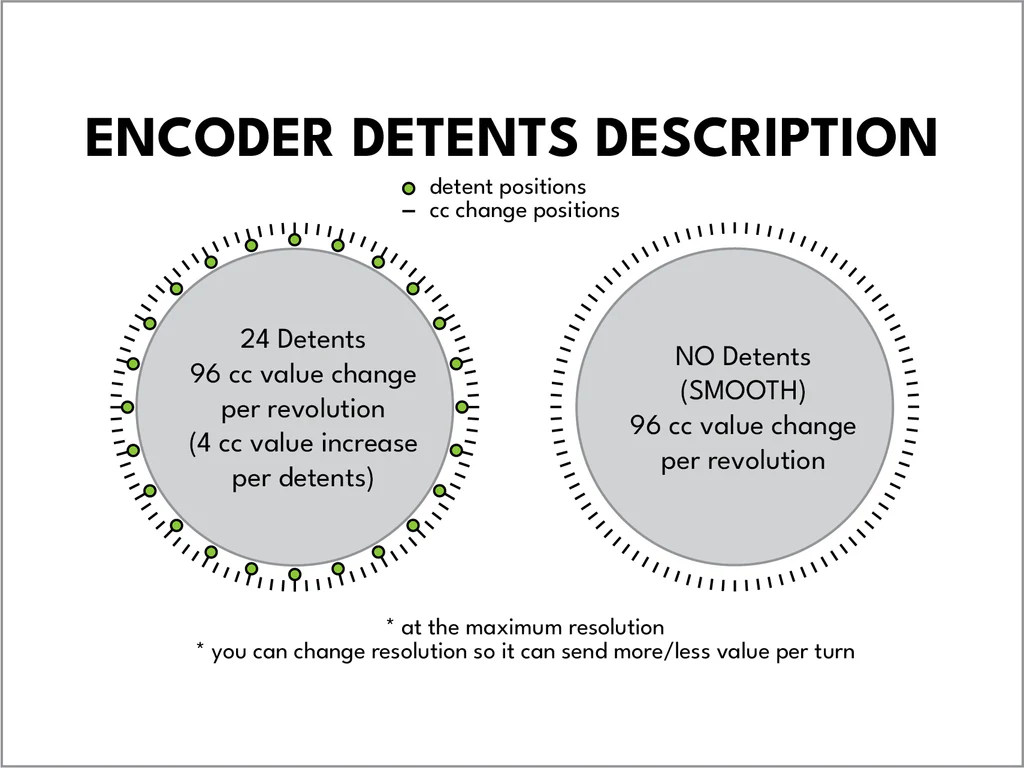Element-specific Manual
This section contains detailed manuals for each product. ParksTool products are universal controllers composed of combinations of Encoders, Potentiometers, Faders, and Keys. This page provides detailed explanations of the characteristics of each element and the models created from their combinations.
Encoders
Circular knobs used in MIDI devices have no markings because they have no absolute position.
The characteristics of encoders are as follows:
Rotation input detection: Encoders detect user rotation movements and convert them into digital signals.
Precision control: Can detect fine step-by-step rotation values, making it suitable for precise control such as volume adjustment or menu navigation.
Switch integration capability: Some encoders include a push (click) function, which can be used for additional input (e.g., selection, confirmation).
In particular, encoders can receive feedback on current position values from DAW (Digital Audio Workstation). Thanks to this feature, even after users adjust values in the DAW, the hardware controller can start control seamlessly from that position, enabling very flexible operation. By setting up the DAW to send MIDI Out to ParksTool devices, the hardware controller can directly control DAW parameters. When you designate ParksTool as the output target in the DAW’s MIDI settings menu, each encoder movement or button input is reflected in the DAW in real time.
Encoders with Detent
Some products use encoders with detent (stop) functionality applied. Encoders with detents provide a bumpy texture when rotating, clicking like a mouse wheel. For example, the 13K1ES-D24 product has detents applied, allowing you to clearly feel the stops at your fingertips.
All encoders that do not include D24 in the product name are smooth type and move smoothly when rotated.

In product codes, encoders are denoted as [n]ES (switch integrated) or [n]EN (switch non-integrated). Example: 4ES means 4 switch-integrated encoders.
Encoders can transmit relative values, allowing them to convey changes such as increases or decreases as signals without knowing the current value (absolute position). This is a distinguishing feature from potentiometers, which must always send the current absolute position value. Therefore, encoders are suitable for menu navigation or repetitive operations, while potentiometers are suitable for situations where users want to operate while visually and manually confirming the absolute position.
Potentiometers
Circular knobs used in MIDI devices (example) have markings as shown in the figure above. You can immediately know what value is currently set by the position of the marking.
The characteristics of potentiometers are as follows:
Absolute position detection: Potentiometers detect the position that users rotate or slide as analog values, converting these values into digital signals. Intuitive control: Users can directly check the position with their hands, making them suitable for settings where absolute values are important, such as volume, tone, and balance.
In product codes, potentiometers are denoted as [n]P. Example: 8P means 8 potentiometers.
Potentiometers always transmit the current absolute value, allowing users to intuitively transmit the desired value. This is a distinguishing feature from encoders.
Faders
30mm stroke: Faders used in ParksTool products provide a 30mm travel distance, enabling delicate and intuitive slide control. Analog position detection: Faders detect the position where users move the slider as analog values and convert these values into digital signals.
In product codes, faders are denoted as [n]F. Example: 1F means 1 fader.
Faders, like potentiometers, also transmit absolute values, allowing users to intuitively manipulate the desired values.
Potentiometers and Faders used in ParksTool are input as 10-bit values. This means they are sufficient in Normal MIDI mode, which can have values from 0-127. However, resolution decreases in 14-bit CC mode.”ontroller Manual package
Keys
Tactile feedback: Keys used in ParksTool products are tactile type, providing clear click feel and rebound when pressed.
Some products use mechanical keyboard switches to provide a more premium and better feel.
Momentary operation: By default, keys operate in momentary mode, sending signals only while being pressed.
Toggle function support: Through the Web Configuration Tool, you can set each key to operate in toggle mode. When set to toggle, the state changes each time it is pressed (e.g., ON/OFF).
In product codes, keys are denoted as [n]K. Example: 2K means 2 keys.
Slide Switch
Almost all products have a slide switch that changes the mode of the TRS MIDI out port. TRS MIDI out comes in Type A and Type B. If TRS MIDI out output is not working well, try changing the slide switch. Thanks to this slide switch, it can operate regardless of the type of TRS to MIDI 5-pin cable.
Product Naming Rules
Product codes are structured according to the following rules:
Encoders: [n]ES (switch integrated) | [n]EN (switch non-integrated)
Potentiometers/Faders: [n]P (potentiometers) | [n]F (faders)
Keys/Switches: [n]K
Expression Pedals: [n]X (3.5mm TRS port)
Manufacturing Year/Month: YYMM
Design Version: 4-digit number
Example: 4ES2K-2506-4005 * 4ES: 4 encoders (switch integrated) * 2K: 2 keys * 2506: manufactured in June 2025 * 4005: design version